In the field of mechanical metrology the IDD is equipped with a universal testing machine from Zwick. Using the two huge test chambers the tool is universally applicable with different adapters designed and modified by the IDD. Especially, these adapters allow the investigation of various problems ranging from mechanical stress of substrates to many aspects of the cutting technology.
All printing methods require special inks or functional fluids that possess defined physical properties. This is why the IDD built up a laboratory for fluid characterization excellently capable of investigating properties like rheological parameters, particle sizes, surface tensions, etc.
For the morphological charakterization of substrates, printing results, anilox rollers, flexo plates or similar the IDD uses standard measurement devices for printing processes and a wide range of optical (up to 100x) and tactile (AFM) microscopes. These include a profilometer that combines confocal, interferometric and atomic force microscopy in a single tool.
General tasks in the scope of measurement and control are covered by hard- and software based technology from National Instruments. This can be easily integrated into existing systems and processes.
Mechanical Metrology
The mechanical metrology at IDD is quite manifold applicable. Mechanical tension tests and measurements can be performed in our climatised room under norm conditions.
The static materials testing machine ZwickRoell Z050 is utilised for strain, shear and bending tests with different substrates and machine components. For fixation of the specimens we can use a lot of several jigs and load cells:
- Load cell (50 N, 1 kN)
- travel measurment system with high resolution (50 nm)
Two devices were designed additionally for precise adjusting the upper and the lower part of the jig to each other.
The jigs were specially fitted to gain reproducible data in the elastic range of the material paper. Related to the corresponding Norms the following jigs are available:
- Ring crush test: MD, CD
- Strip tension test: MD, CD
- Compressive test: ZD
- Diverse compressive pistils in several sizes with corresponding flat counter pressure plates
- Peel test apparatus
Technical specifications:
- Force: < 50 kN
- Positioning, repetition accuracy: ± 2 μm
- Accuracy of the set speed: 0,004 % von Vnenn
- Drive system´s travel resolution: 27 nm
- Travel resolution external travel sensor: 50 nm
- Crosshead speed: 0,0005 – 2000 mm/min
- Test area width: 630 mm
- Height of the test area with additional traverse: 1735 mm (divided in two test areas)
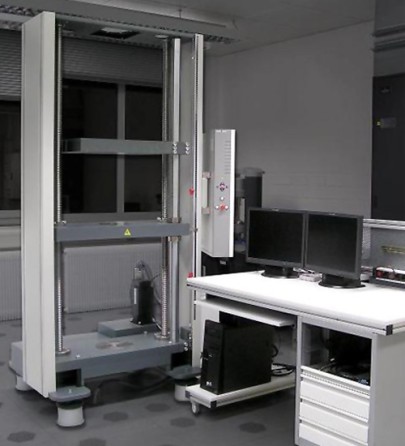
The DektakXT of the manufacturer Bruker is tactile profilometer which makes it possible to determine and characterize layer thicknesses and topographies as well as their roughness with a vertical resolution of 1 Å using a diamond stylus. The probes to be examined can be moved on a vaccum table in x and y direction as well as be rotated 360 ° software-controlled. The software enables to run pre-set measurement series and analysis routines fully automatically.
Technical specifications:
- repeatability < 5 Å
- diamond styli: 12,5 µm and 2,5 µm
- stylus force: 0,03 mg to 15 mg (N-lite+ Low Force Setup)
- data points per scan: 120.000 (max)
- vertical scan range: 1 mm (max)
- vertical resolution: 1 Å (@ 6.55 µm range)
- max. scan length range: 55 mm (200 mm with scan stitching capability)

For determining the surface hardness of matetrials two Shore meters of different manufacturers are available. Both are applicable for Shore A. One comes from the Manufacturer Franke and one from the company ZwickRoell. Here this one is explained in detail.
Technical specifications:
- Device Zwick 3114 (Shore A)
- Truncated cone opening angle: 35°
- Contact force: 12,5 N
- Spring force: 8,065 N
- Range of applications: Soft rubber, elastomers, Natural rubber, PVC soft

A measuring stand for Shore D hardness is available for determining the surface hardness of plastics such as cured resins and thermoplastics. This is the HDD 100-1 Shore hardness tester from Sauter in conjunction with the lever stand for uniform guidance and reproducible measurement. The hardness tester can perform two-point calibration and display peak values or average values. The contact force is 50 N, the measuring range covers 0 to 100 Shore D, the measured values are readable to 0.1 and the manufacturer specifies a tolerance of 1%.

For determining the thickness of rubber blancets there is a thickness gauge of the company Streb. It allowes measurements due to DIN 16621 / ISO 12636. The geometry of the special disc and the compression spring is carefully designed. It can determine even the thickness of foiles or cliche (at fulltone).
Technical specifications:
- Dial gradation: 0.01mm
- Measuring range: 10mm
- Disc daimeter: 10mm
- Measuring pressure: ca. 5-6 N/cm²

Optical Characterization
For the morphological characterization of substrates, printing results, anilox rollers, flexo plates or similar the IDD uses standard measurement devices for printing processes and a wide range of optical (up to 100x) and tactile (AFM) microscopes. These include a profilometer that combines confocal, interferometric and atomic force microscopy in a single tool for three-dimensional surface determination with a vertical range of a few nanometers.
The Sensofar PLu Neox is a profilometer that combines confocal microscopy, white-light interferometry, phase-shift interferometry and atomic force microscopy in a very unique way. Additionally, a spectroscopic reflectometer enables the user to measure the thickness of semi-transparent layers. The profilometer is equipped with a controlled displaceable vacuum table capturing samples with the maximum size of 30cm x 30cm.
Technical specifications:
- Minimal vertical resolution
- Confocal microscopy: 3 nm
- White-light interferometry: 1 nm
- Phase-shift interferometry: 0,01 nm
- Spectroscopic reflectometry: 0,1 nm
- Objektives
- Interferometric: 5x, 10x, 20x, 50x
- Confocal: 5x, 10x, 20x, 50x

The VR-5200 3D profilometer made by Keyence can capture the surface, shape and contour of components within a very short time using structured light, or more precisely the light section method. Thus, surfaces can be characterized (e.g. roughness according to DIN EN ISO 25178 and DIN EN ISO 4287), measurements on 3D surfaces can be performed and highly precise 3D models can be fed back.
- Measuring area max. 206 mm × 104 mm
- Height resolution: 0.1 µm
- Accuracy in Z: ±2.5 μm
- Accuracy in XY: ±2 μm
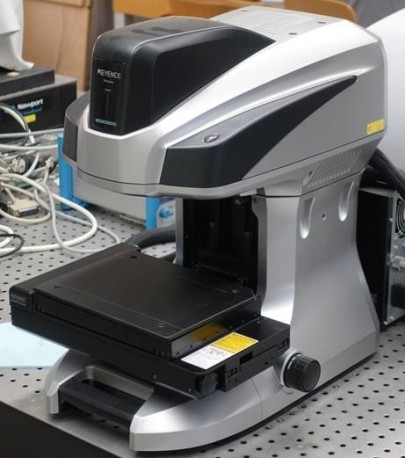
Photron's FASTCAM Nova S12 high-speed camera allows processes to be recorded at a frame rate of 12,800 frames per second (fps) at a full resolution of 1,024 x 1,024 pixels in 12-bit grayscale. At reduced resolution, frame rates of 1,000,000 fps are possible at a resolution of 128 x 16 pixels. A 10 Gigabit Ethernet interface is used for data transmission. Lenses with C-mount or F-mount can be connected. According to the manufacturer, the 1-megapixel CMOS image sensor has a best-in-class light sensitivity of ISO 64,000, which makes the camera very suitable for recording processes under extremely challenging lighting conditions.
Technical specifications:
- 12.800 fps @ 1.024 x 1.024 Pixel resolution
- 1.000.000 fps @ 128 x 16 Pixel resolution
- C-Mount- & F-Mount
- High sensitivity: ISO 64.000


The High-speed-camera FASTCAM SA4, produced by Photron, enables to directly observe processes with a frame rate of 3600fps @ 1024 x 1024 pixel resolution. Using a reduced resolution of 128 x 16 pixels, it is possible to observe with a frame rate as high as 500000fps. The communication is established via ethernet with a maximum transfer rate of 1000mbit/s. Lenses using C-Mount- or M42-threads can be used.
Technical specifications:
- 3600fps @ 1024 x 1024 Pixel Resolution
- 500000fps @ 128 x 16 Pixel Resolution
- C-Mount- and M42-Mounting

The DM4000M is a high-level, half-automated microscope for research purpose. It combines incident light bright- and darkfield as well as transmitted light and polarization contrast microscopy. Adapting the external UV-light source enables fluorescent coloured pictures of the specimen. The motorized scanning table in combination with the colour CCD camera and the measurement software allows the user to create multi-step or multi-focus images. The objectives ranging from 2.5x to 100x gives an excellent variety of handling all kind of different samples.

With the measurement device iCPlate II the tonal values of a printing plate can be measured. A camera captures an image of the printing and non-printing elements of the plate. From this image the iCPlate II calculates the surface ratio, tonal value, raster frequency and angle.
Technical specifications:
- Light source: LED (R,G,B)
- Area of detection: 1 mm x 1,3 mm

The digital microscope DMS910 measures the tonal values of a printing plate. A camera captures an image of the printing and non-printing elements of the plate. From this image the DMS910 calculates the surface ratio, tonal value, raster frequency and angle.
Technical specifications:
- Detection: RGB camera
- Area of detection: 0,7 mm x 1,0 mm
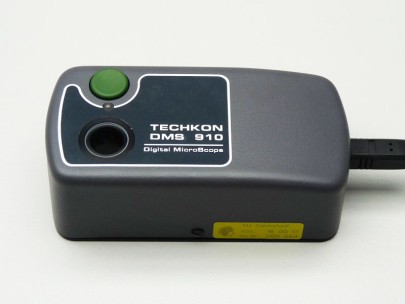
The luminance meter of the manufacturer Gossen makes it possible to measure the luminance of a luminous surface in candela per square meter (cd/m²) or foot-lambert (fL). The luminance meter is classified in Class B according to DIN 5032-7, DIN EN 13032-1 Annex B and CIE 69. With a deviation of f1' < 3 %, the adaptation to the spectral brightness sensation of the human eye V(λ) is better than the requirement from the standard.
Technical specifications:
• Luminance [lux]: 0,01 cd/m² … 19 990 cd/m² / 0,001 fL … 1999 fL
• Measuring rate: 2/s
• Measuring method: Attachment measurement
• Measuring sensor: Silicon photodiode with V (λ) filter
• Accuracy: ± 2.5 % of reading ± 2 digit

The Minilux is a small portable illuminance meter. Using a circular receiver with a diameter of 10 mm, it measures the illuminance in lux in the range from 1 mlx to 200 klx, divided into 6 measuring ranges.

A photo station, often called a repro station, is available for documentation and imaging of larger specimens.
It consists of a gridded table with a tripod. A camera is attached to the tripod. Two photo lights on the side of the camera and an illuminated panel that can be placed on the table are available for illumination. The positions of the camera arm and illuminators, as well as the settings of the illuminators, are provided with scales so that a reproducible shooting situation can be created. The illumination is based on LEDs.
Technical specifications:
- Camera: Canon EOS 70D with 20 MP, EF 24-105mm zoom lens
- Illuminated panel: 42.9 x 30.9 cm, color temperature 5000 K, color rendering index CRI = 95 Ra, luminance = up to 650 cd/m²
- Side illumination: color temperature 3200 to 5600 K adjustable, color rendering index CRI = 93-95 Ra, luminance up to 212 lux/m

The UVPadE from Opsytec is a spectrometer that can simultaneously characterize the spectral distribution as well as the irradiance of a UV radiation source. The measuring head is very flat and can therefore also be inserted into gaps in industrial UV dryers. Otherwise, the measuring device is very well suited for characterizing UV sources of all kinds, such as LEDs, stereolithography-based 3D printers and their post-curing chambers.
- Spectral range: 240 – 480 nm
- Intensity range: approx. 2 – 5,000 mW/cm²
- Sensor head: 10 mm height, 40 mm diameter
- Cable length light guide: 1.5 m

Characterization of fluids
The study of materials involved in the printing process plays an important role in research. In particular, the material properties of fluids are of outstanding interest because they have a great influence on the printing process. The equipment at the IDD allows, not only the measurement of the most important material specifications, but also extensive characterizations with many variable parameters. The focus here is on the rheology, contact angle measurements and tensiometry.
Malvern Panalytical's KINEXUS lab+ air-bearing rotational and oscillation rheometer can be used to test a wide range of fluids for their viscosity and their dependence on parameters such as temperature, time and shear rate. A variety of cone-plate and plate-plate geometries are available for this purpose. Thanks to an actively temperature-controlled hood, the temperature in the entire sample room can be controlled very precisely. Curing of UV-crosslinkable materials can be carried out using disposable geometries and a temperature-controlled UV measuring cell. In addition to tests for visco-elastic behaviour, squeeze and tack tests as well as tensile and compression tests using normal force measurement are also possible.
Technical specifications:
- Temperature range: -40 °C to 200 °C (resolution 0.01 K)
- Torque range: 10 nNm to 200 mNm (resolution 0.1 nNm)
- Normal force range: 1 mN to 50 N (resolution 0.5 mN)
- Angular velocity: 10 nrad/s to 350 rad/s
- Angular resolution: < 10 nrad
- Frequency range: 1 µHz to 100 Hz
- Gap accuracy: 0.1 µm
- Sample volume: from approx. 0.3 ml

The Thermo Scientific Haake CaBER extensional rheometer is used for characterizing the extensional viscosity properties of fluids. The measurements are complementary to the characterizations on the Haake MARS. A small fluid drop is stretched between two plates and the diameter of the generated filament is observed. If the surface tension is known, the extensional viscosity can be calculated. The measurement of the axial forces and the positioning of the upper plate enable further testing options.
Technical specifications:
- Temperature range: 0° C bis 80° C
- Accuracy of the laser micrometer: 8 µm
- Sampling rate: 0,1 ms
- Axial Force: 0,05 – 10 N
- Minimal strike time: 20 ms
- Amount of fluid needed: ca. 0,2 ml

The DSA 100 of Kruess is a modern, computer controlled contact angle measurement system. The 5-syringe dosing system allows the use of different reference fluids for measuring the interfacial surface tension of solid materials like substrates (glass, foil), printing plates and printing rollers. Additionally it is possible to measure the static surface tension of fluids with the “pendant drop” method. Temperature dependent tests can be performed in a chamber with different environmental conditions. Also solvent atmospheres can be adjusted. The acquisition of the measurement data is done by a FireWire camera with 60 frames/s and computed by a modern PC Software.
Technical specifications:
- Temperature range: -10° C bis +100° C
- Dosing: 5-syringe automatic + one manual dosing system
- Camera: 60 frames/sec.
- Probe positioning: manual moveable X-Y-Z table

The surface tension of most printing inks changes within time and temperature, which has an essential impact to their wettability properties. With the KRÜSS Bubble Pressure Tensiometer BP100 the dynamic surface tension of fluids down to surface ages of 5 ms between -10° C and 100° C can be measured.
Technical specifications:
- Temperature range: -10° to +100° C
- Surface age: 0,005 to 100 s

The Nicomp 380 DLS is a particle size analyser for fluids with particle sizes from 1 nm to 5 microns. The measurement is performed by dynamic light scattering at a 90 ° measurement arrangement over 1024 channels. The sample volume is 2 ml and can be reduced to a few µl in special cases. A peltier element, working in the range of 5-65 °C, can be used for tempering the sample during the measurements.
Technical specifications:
- Measurement method: Dynamic light scattering
- Measurement arrangement: 90° scattering
- Resolution: 1024 channels
- Particles size: 0.001 to 5 microns
- Temperature: 5 – 65°C
- Sample volume: 2 ml

The Pocket-Goniometer is used to measure the contact angle of a fluid drop on a solid substrate. The wetting of a specific fluid and substrate combination can be observed. The device is portable and can be operated in areas, where the use of the DSA 100 is impossible. Disadvantageous is the smaller measurement accuracy.
Technical specifications:
- Image resolution: 640 x 480 Pixel
- Minimal dosing volume: 0,5 µl

Controlling Devices
The HX204 from Mettler Toledo can be used to determine the moisture content or dry weight of samples. This is possible with liquid samples, gels, fibers, papers, polymer granulates, printed layers on substrates and other samples. For this purpose, the sample is heated in a controlled manner with a halogen heating element and weighed in the process. Up to 300 measurement methods can be created. These can be checked in a test run and adjusted before the first use. The measurement data is shown on the color display, stored internally and can be transferred via LAN or USB. The instrument has an internal calibration, warns automatically if it is not leveled, and can be checked regularly for correct function using a proof substance. The instrument can be easily disassembled for cleaning.
- Readability up to 0.001 % (0.1 mg) moisture content
- Repeatability: 0.05 % with 2 g and 0.01 % with 10 g sample
- Sample weight maximum 200 g
- Sample pan: diameter 90 mm, maximum sample height 15 mm
- Temperature from 40 to 230 °C
- Drying programs: gentle, normal, fast, programmable steps
- Endpoint definition: time-controlled, automatic with 5 different criteria (mass loss per time) or freely definable via weight loss in mg or % over a defined time

This device allows capture and logging of rapidly variable, periodical or transient electrical signals at a high sampling rate. It offers a lot of user-friendly additional functions, e.g. a front-USB-connector for data recording and transfer, automatic range scaling, multilingual user interface and optional battery driven operation for mobile applications.
Technical specifications:
- Cut-off-frequency: 500 MHz
- Recording channels: up to 4
- Sampling rate: up to 5 GS/s
- Interfaces: USB, RJ45, GPIB, serial
- Standard recording length: 10000 points on each channel

A high-quality transistor measuring station consisting of an Agilent B1500A semiconductor device parameter analyzer along with Cascade Microtech’s EPS150 probe station is available at the IDD. The probe station is equipped with four finely adjustable micropositioners and an attached microscope with USB camera for precise contacting of the devices. The Agilent B1500A is connected to it and can record characteristics of transistors, capacitors and other electrical components and extract parameters such as mobility and threshold voltage. More complex measurements of memory components and long-term measurements e.g. under electrical stress for testing the durability of a device are also possible.
Technical specifications:
- Maximum sample size: 150 mm diameter
- 4 micropositioners
- Measuring range of voltage: 0.5 microvolts to 200 V
- Measuring range of current: 0.1 fA to 1 A
- 3 source measurement units (SMU)
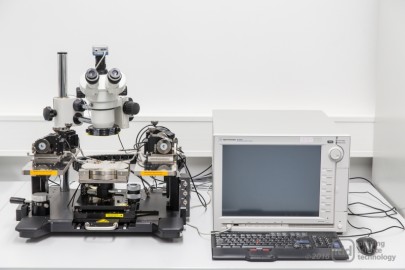
The FischerScope MMS PC is a measurement system, where different sensors can be applied.
The eddy current sensor FTA2.4-MC allows for measuring the thickness of films on base materials for special material combinations: non-conductive films on conductive but non-magnetizable base materials and non-ferrous metals on insulating base materials. Due to the slim design of the sensor and a guiding stand, it is also possible to measure samples with concave surfaces.
Technical specifications:
- Modul: PERMASCOPE
- Sensor: FTA2.4-MC
- Measurable Thickness: 2 – 1200 µm
- Calibration foils: 12 µm, 24,3 µm, 295 µm

The MFIA impedance spectrometer from Zurich Instruments is used to measure the complex electrical resistance of material samples over a wide frequency range. This allows conclusions to be drawn about the mobility of ions in a hydrogel and diffusion and relaxation mechanisms to be identified at molecular level. The sample to be examined is connected to the device using electrodes.
Measuring method: EIS (Electric Impedance Spectroscopy)
Frequency range: 0 to 5 MHz
Voltage range: 0 to 3 V
Impedance measurement method: 2-point, 4-point.
Electrical interface to the sample: BNC or electronic plug-in board (2.54 mm grid)
Operator interface: via laptop/PC (MS-Windows) via USB interface or TCPIP
Location: IDD laboratories, portable.
The device is also suitable for recording electrical signals and for noise analysis on electrical systems, ionic conductors, hydrogels, cell substrates.
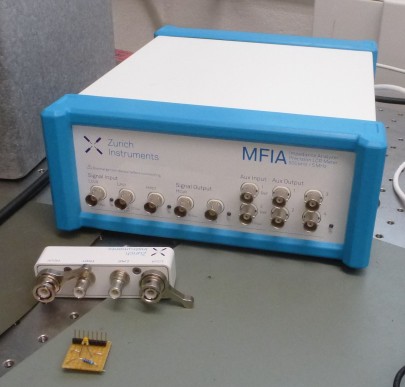
The Nagy instruments SRM-14T is a device for the contactless measurement of sheet resistivity. Metal layers on insulating substrates or within insulating layers can be characterized. There are two measuring heads with a measuring range of 0.5 to 20 ohm/sq and 0.5 to 20 ohms/sq available.

The test site consists of a probe station by Intertek and two source-meter units of the type 2400 from Keithley. For characterizing transistors different measurement rules are defined, but which can be adjusted as needed. There are rules for determining the source and transfer characteristic line of organic transistors with p-and n-type semiconductors available. The mobility of the semiconductor can be determined afterwards. In addition to that the resistivity of a closed, theoretically any sized and shaped layer can be determined by the use of the method of Van-der-Pauw, if the thickness of this layer was previously determined externally.
Technical specifications:
- 4 needle holders by Carl Suss
- Vacuum plate
- Lockable to measure without influences of light
- Leica stereo microscope
- 5μV to 210V, 50pA to 1.05 A, 100μOhm to 211MOhm; to a maximum of 22W output power

With the multicomponent dynamometer it is possible to measure all orthogonal components of dynamic and quasi-static forces stressing the platform, as well as all moments acting on it.
The platform consist of a Kistler quarz-3-component dynamometer type 9255B, the appropriate charge amplifier type 5070A11100 und necessary cables. The resulting analog signal can be interpreted by NI hardware.
Technical specifications:
- Length: 260 mm
- Width: 260 mm
- Height: 95 mm
- Weight: 5.2 kg
- Protection class: IP67
- Measuring range in x,y: +-20 kN
- Sensitivity in x,y: ≈ -8 pC/N
- Measuring range in z: -10 to +40 kN
- Sensitivity in z: ≈ -3.7 pC/N

There are various quartz-based accelerometers, a load cell and an impact hammer from Kistler available. They are connected and evaluated by a NI-9234 module, from the CompactRIO system of National Instruments. Available components are:
- Accelerometer with +- 100g measurement range type 8702B
- Accelerometer with +-50g measurement range type 8702B
- Accelerometer with +- 25g measurement range type 8702B
- Load cell with 250lbf measurement range type 9712B
- Magnetic mount type 8452
- Mounting block 8502
- Impact hammer with frequency range 6900 Hz (-10 dB) type 9724A5000


The CompactRIO offers a real-time-platform with a reconfigurable FPGA-chip and can be easily programmed in the LabView environment. Consequently, data can be processed in parallel at a rate of 40 Mhz. Aggregated data can be accessed by the real-time-system via a DMA-interface and can be saved to the internal memory. The network connectivity allows a visualization and control of the data on a remote computer. For data acquisition and signal generation the following modules can be used:
- cRIO-9074 integrated real-time controller running at 400 MHz and a FPGA with 2M. gates
- cDAQ-9171 USB chassis for modules of the c-series
- 2x USB-9162 USB chassis for modules of the c-series
- 3x 9411 digital input module with 6 channels, 500 ns and ±5 bis 24 V
- 9215 analog input module with 4 channels, 100 kS/s per channel, 16 bit; ±10 V
- 2x 9401 bidirectional high-speed digital I/O-module with 8 channels, 5 V/TTL
- 2x 9237 bridge module with simultaneous sampling; 4 channels, 24 bit, ±25 mV/V
- 9219 universal analog input module with 24 bit
- 9472 digital output module with 8 channels, 24-V-logic, 100 µs
- 2x 9263 analog output module with 4 channels, 100 kS/s, 16 bit, ±10 V
- 9234 analog input module for accelerometer, 4 channels, ±5 V, 51,2 kS/s per channel, 24-bit-IEPE

The existent PXI System is equipped with various measurement adapters and cards. The PXI-system can be operated by Windows or even an NI own operation system. Both of them make the sytem usable for measurement and control applications. The system is programmable via the standard LabView software. One feature of the LabView own operation system is the real time fielding of measurement and control tasks with no compromise.
Following I/O-cards with compatible cables and connection blocs are to hand:
- PXI-8106 RT Embedded Controller as platform for operation systems
- PXI-6521 Output for mechanic relays with 150 V, digital inputs with 30 V loading capacity
- PXI-5900 differential preamplifier for PXI-5922 oscilloscope with a bandwidth 6 Mhz
- PXI-5922 two channel oscilloscope with a resolution of 24bit at 500 kS/s and 16bit at 15 MS/s
- PXI-6251 high speed multifunction data acquisition module, A/D-Converter 16 bit
- PXI-6281 high precision multifunction data acquisition module, A/D-Converter 18 bit

The complete range of National Instruments products is available at IDD. Part of it are LabView and DIAdem always in its latest software version. Compatible hardware is programmable by LabView with real time measurement and control applications. The system is accessible via remote-control by web-browser and FTP connection. All measurement and control algorithms are user definable. DIAdem allows fast and incomplex data analysis and report generation.
Different file formats of acquired data can be read and displayed. In addition to it several tools for data analysis are accessible and automatic operable: simple addition of data channels, filter of acquired data up to FFT calculations. All this can be exported in reports.

The CompactRIO offers a real-time platform with a reconfigurable FPGA chip and can be conveniently programmed in the LabView environment. Data can be processed and evaluated in parallel at up to 40Mhz per cycle. Aggregated data can be transferred and stored in the real-time operating system via a DMA interface. The network capability makes it possible to visualize and monitor the data on another computer. The following components are available for data input and output:
- cRIO-9047 Integrated real-time controller with 1.6 GHz and NI-DAQmx compatibility, 8 slots
- cRIO-9074 Integrated real-time controller with 400 MHz and FPGA with 2 million gates
- cDAQ-9171 USB chassis for C-series modules
- 2x USB-9162 USB chassis for C-series modules
- 3x 9411 Digital input module for 6 channels, 500 ns and ±5 to 24 V
- 9215 Analog input module with 4 channels, 100 kS/s per channel, 16 bit; ±10 V
- 2x 9401 Bidirectional high-speed digital I/O module with 8 channels, 5 V/TTL
- 2x 9402 Digital input/output module with 4 channels, LVTTL with 55 ns, I2C compatible
- 2x 9237 Bridge module with simultaneous sampling; 4 channels, 24 bit, ±25 mV/V
- 5x 9219 Universal analog input module with 24 bit
- 9472 Digital output module 8 channels, 24 V logic, 100 µs
- 2x 9263 Analog output module with 4 channels, 100 kS/s, 16 bit, ±10 V
- 9234 Analog input module for accelerometers 4 channels, ±5 V, 51.2 kS/s per channel, 24-bit IEPE



